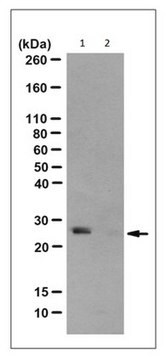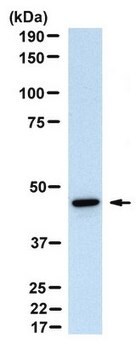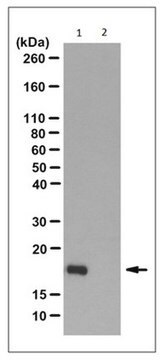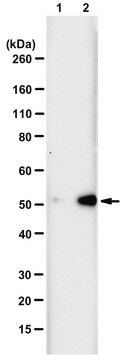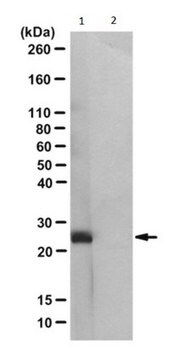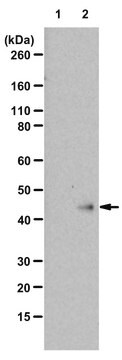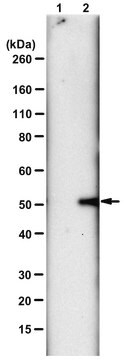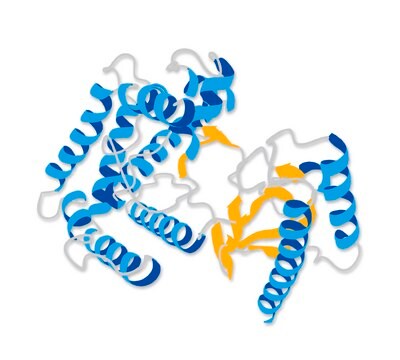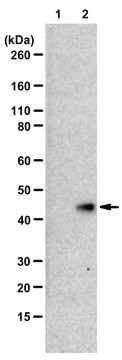MABS1330
Anti-N1-Phosphohistidine (1-pHis) Antibody, clone SC1-1
clone SC1-1, from rabbit
Sinónimos:
N1-Phosphohistidine
About This Item
Productos recomendados
biological source
rabbit
Quality Level
antibody form
purified antibody
antibody product type
primary antibodies
clone
SC1-1, monoclonal
species reactivity
E. coli, human
species reactivity (predicted by homology)
all
technique(s)
affinity chromatography: suitable
dot blot: suitable
immunocytochemistry: suitable
western blot: suitable
isotype
IgG
shipped in
wet ice
target post-translational modification
phosphorylation (N1-pHis)
General description
Specificity
Immunogen
Application
Western Blotting Analysis: A representative lot detected heat-sensitive histidine N1-phosphorylation (1-pHis) in multiple cell lysates (Fuhs, S.R., et al. (2015). Cell. 162(1):198-210).
Immunocytochemistry Analysis: A representative lot detected N1-phosphohistidine (1-pHis) immunoreactivity distinct from that of 3-pHis in 4% paraformaldehyde-fixed HeLa cells and murine bone marrow-derived macrophages by fluorescent immunocytochemistry. The 1-pHis immunoreactivity was found in regions surrounding acidic compartments, but not inside these compartments or nuclei (Fuhs, S.R., et al. (2015). Cell. 162(1):198-210).
Immunoaffinity Purification: A representative lot was cross-linked to protein A resins for immunoaffinity purification of 1-pHis proteins from cell lysates prior to LC-MS/MS analysis (Fuhs, S.R., et al. (2015). Cell. 162(1):198-210).
Note: DO NOT HEAT SAMPLES prior to phosphohistidine detection. Histidine phosphorylation is heat and acid labile. To generate negative control for specificity test, an aliquot of sample can be heated at 95ºC for 10-15 minutes to reverse histidine phosphorylation. Alternatively, an aliquot of sample can be incubated under acidified pH at 37ºC for 15 minutes to reduce histidine phosphorylation. Acidify each 100 µL sample with 25 µL of 1 M HCl before the incubation, then neutralize with 25 µL of 1 M NaOH prior to phosphohistidine detection.
Quality
Western Blotting Analysis: 0.3 µg/mL of this antibody detected recombinant human NME1 (NM23-H1) with N1-phosphohistidine (1-pHis) in a 5 µg aliquot of autophosphorylation reaction.
Target description
Physical form
Other Notes
¿No encuentra el producto adecuado?
Pruebe nuestro Herramienta de selección de productos.
Optional
Storage Class
12 - Non Combustible Liquids
wgk_germany
WGK 1
flash_point_f
Not applicable
flash_point_c
Not applicable
Certificados de análisis (COA)
Busque Certificados de análisis (COA) introduciendo el número de lote del producto. Los números de lote se encuentran en la etiqueta del producto después de las palabras «Lot» o «Batch»
¿Ya tiene este producto?
Encuentre la documentación para los productos que ha comprado recientemente en la Biblioteca de documentos.
Nuestro equipo de científicos tiene experiencia en todas las áreas de investigación: Ciencias de la vida, Ciencia de los materiales, Síntesis química, Cromatografía, Analítica y muchas otras.
Póngase en contacto con el Servicio técnico